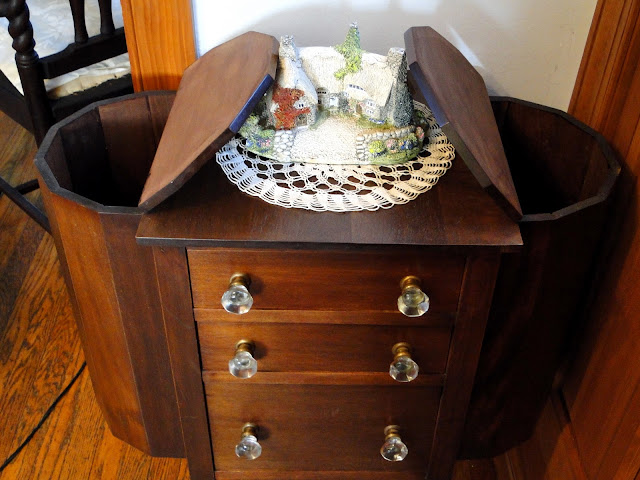This was the special little item I found at one of the antique shops we looked around. after a Tea lunch with my friend C.
 |
| Martha Washington Sewing Cabinet |
 |
| Probably from the depression era. The bins have seven sides and the legs are turned, so nicer than some cabinets. |
 |
| I don't think the draw pulls are original, I think they would have been wood, but I like the glass. |
|
|
|
 |
| I like the deep bin type storage either side. The cabinet is finished on all sides to be free standing and for ladies to sit around and sew. |
The sewing or “lady’s work” table is a splendid example of one of the most elegant and functional forms of furniture to be introduced in America during the Federal period. Small, delicate, and portable, it was designed to provide a convenient surface and storage space for needlework and other leisure activities of gentlewomen. It performed its tasks so well that by the era’s end it had become a focal object of refined feminine society.
In the Federal period—roughly 1785 to 1810—it was customary for the women of the household, and sometimes visitors as well, to gather in a sitting room or parlor and arrange themselves around the sewing table. Some would take up their embroidery or crewelwork, while another might compose a letter or read aloud to the group. One such scene comes to life in the August 20, 1824, journal entry of Margaret Quincy, daughter of the president of Harvard University: “Mama and I were ready dressed, so descended to the parlour, opened windows, dropped blinds, placed the little table in the middle of the room with work, books, etc., etc., and seating ourselves on the sopha, Mama held some work and I read aloud Red Gauntlet.”
During the harsher colonial period most women took up their needles only when they had to. Clothing was entirely homemade, darning and mending perpetual chores. But by the end of the eighteenth century, needlework had become a recreational activity as well.
One of its most zealous practitioners was the nation’s first First Lady. Hardly a description of Martha Washington survives without mention of her hyperactive hands. A contemporary visitor to Mount Vernon, for instance, described her as “incessantly knitting,” and an early biographer wrote that “even when she sat down to visit or rest the knitting needles danced under her chubby fingers.” During the Revolution Mrs. Washington organized a sewing and knitting circle in her Cambridge parlor to do mending for bachelors and to make bandages for a nearby hospital. Her interest endured until late in life; at the age of sixty-nine she was busy at work on a dozen needlepoint chair cushions. To this day there is a variety of lady’s worktable, distinguished by its oval top over two or three small drawers—a type used at Mount Vernon—that is still referred to as a Martha Washington sewing table.
It performed its tasks so well that by the era’s end it had become a focal object of refined feminine society. |
The lady’s worktable originated in England around 1770, but the Revolutionary War and the economic depression that followed it kept Americans from adapting new furniture forms and design precepts until the late 1780s. Then there began to emerge a new class of merchants affluent enough to build substantial houses and fill them with stylish furnishings.
Although some American sewing tables were made in the Hepplewhite style, the majority were in the Sheraton and Empire modes. Lightweight and delicate, they were most often constructed of mahogany, sometimes partially veneered with maple or satinwood. Fitted with shallow drawers in which to store such sewing accessories as thread and bobbins, the tables often came outfitted with other accoutrements as well: as a writing drawer or perhaps a backgammon or chess board. The pouch variety was especially popular; its silk bag, designed to hold fancywork, might be gathered or pleated or draped flush with the table.
Christy


 3 Topping Options
3 Topping Options
 Clotted cream is a thick yellow cream made by heating unpasteurized cow's milk and then leaving it in shallow pans for several hours. During this time, the cream content rises to the surface and forms 'clots'. Clotted cream purists prefer the milk to come from cows in the English counties of Devon and Cornwall.
Clotted cream is a thick yellow cream made by heating unpasteurized cow's milk and then leaving it in shallow pans for several hours. During this time, the cream content rises to the surface and forms 'clots'. Clotted cream purists prefer the milk to come from cows in the English counties of Devon and Cornwall. 
